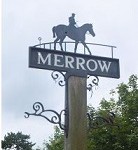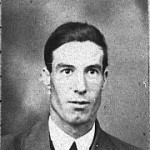“AN EXCELLENT FOSTER MOTHER”
In the early years of the 20th century, Poor Law Guardians in Guildford and throughout the country were concerned about children growing up in the Workhouse, especially if they had been orphaned or abandoned. One solution was Boarding Out. We would call this Fostering. There were many prospective Foster Mothers in the Guildford area, but first they were checked by the Ladies Visiting Committee to see if they could provide a suitable home. A small fee of approximately four shillings’ maintenance was provided, but no more than two children should be boarded in the same home.
One Foster mother was singled out by the Guardians for special praise. In 1911 it was written in the Minutes of the Board of Guardians that Mrs Emma Styles of Merrow had been an excellent Foster Mother since 1901. But there is evidence that Emma had been looking after children unofficially since 1881 when listed in her household in Merrow Street is Emma Mumford, age 6, boarder from London. In 1891 Emma Styles and her husband Henry are looking after two “nurse children”, Ada Stanley, age 10, from Dover and her sister Ellen, age 8, born in Lewes.
By 1901 Emma was a widow and her boarder was Lucy E Bailey, age 12, born in Hastings. Lucy was an orphan whose father, a fisherman, died at sea. She became a domestic servant for a bank manager’s family in Hove, Sussex. In 1911 once again Mrs Styles had two girls boarding with her, Ida Sole, age 14, born in Albury and Grace Anderson, 13, from Dartford. Ida had been living at the Workhouse in 1901 without any other member of her family.
Emma Styles had been born Emma Cannon in Albury, Surrey in 1833. She married Henry Styles, an agricultural labourer, on Christmas Day 1856 and they had three children. She died, living in Horseshoe Lane, Merrow in February 1915 age 82.
SCATTERED HOMES
We were thrilled to receive an email from David Mayo, in response to our request for contacts whose family members were residents in two of the Guildford Scattered Homes. In fact he was able to tell us about a whole family connected with Guildford Union from 1891 until 1911.
Susan Mayo was born in Sussex, but by 1871 she was living with her parents in a caravan at Summers Lane, Godalming. Susan had 5 children. Her first child, George, was born on Christmas Day 1884 but by 1891 he and his mother were living in Guildford Union Workhouse. In March 1900, fifteen year old George was sent for naval training at Devonport. He completed his apprenticeship in September 1902 and served on the NW Frontier with the Royal Artillery, both during and after the First World War.
Meanwhile, Susan and her other children, 9 year old Rose, 7 year old Percy, 3 year old Ellen and 10 month old Ivy can be found back in Guildford Union Workhouse in 1901. The Board of Guardians were aware that the Workhouse was not the most suitable environment in which children should grow up, so in 1903 they decided, as an interim measure, to set up two “Scattered Homes.” These first homes were only for boys and Percy Mayo was one of the 12 boys who went to live with a Housemother at “Branksome” in Woodbridge Road. Occasionally mothers like Susan were allowed to leave the Workhouse to visit their children in the Scattered Home.
By 1904, a girls’ Scattered Home called Providence House had been established at 28 Artillery Road and 4 year old Ivy Mayo was one of the girls chosen to move there. It is probable that her 7 year old sister, Nelly (Ellen) was already living there as both girls are listed at Providence House in the 1911 census.
Their older sister, Rose Mayo, had been selected in May 1906 for a month’s trial as a housemaid with Mr and Mrs Schollick in Haydon Place, Guildford. Rose may have worked there for longer than a month but by November 1906 she and another girl from the workhouse were sent to the Church Army Home in Cheltenham. By 1911 Rose was working as a housemaid in Uxbridge.
Percy became a merchant seaman and at the end of the First World War he was awarded the British War Medal and the Mercantile Marine Medals. He served his country again in World War Two.
FROM THE WORKHOUSE TO CANADA
George, Albert and Walter Tickner
In March 1903 the Local Government Board wrote to each Poor Law Union on the subject of the emigration of orphaned and deserted children. Masters of the workhouses were instructed to prepare lists of children desirous of being emigrated.
Children in Guildford Union Workhouse were asked if they wished to emigrate and in April 1903, the minutes of the Board of Guardians report that three brothers, George, Albert and Walter Tickner, wished to go to Canada. They were sent to Nova Scotia, Canada on the SS Siberian which sailed from Liverpool on the 30th May 1903 and arrived in Nova Scotia, Canada on the 12th June 1903.
The Tickner brothers are listed in the 1901 census in the Guildford Union as paupers. They were the children of Alfred and his wife, Elizabeth Glover, whom he married in 1890 at St John’s Farncombe, Surrey. He was aged 24 and a labourer, son of James Tickner, also a labourer. Elizabeth was aged 22 and a machinist living in Busbridge, her father was Charles Glover, a dyer. Alfred made his mark, Elizabeth signed her name. Their first child, Alfred Charles, was baptised at Farncombe on the 28th September 1890, but died aged ten months and was buried in Nightingale Cemetery, Godalming on the 13th July 1891. The 1891 census lists Alfred, Elizabeth and Alfred Charles living in Farncombe Street. Alfred was born in Godalming and Elizabeth born in Worcester. Albert Tickner was born on the 22nd October 1893 and baptised at St John’s Farncombe on the 28th January 1894, Walter Charles was born on the 19th July 1895 and baptised at Farncombe on the 6th October 1895. On the 6th October 1896 Alfred Tickner, was buried in Nightingale Cemetery, aged 30, a labourer of Bridge Street, Godalming. Three and a half months later a daughter, Beatrice Kate, was born on the 26th January 1897 and baptised on the 12th February 1897 at St Peter and St Paul Church in Godalming.
Elizabeth was left with a newly-born daughter and three boys. In 1899 Elizabeth Tickner married Richard Symes (registered in Guildford). A new marriage possibly meant there was no room for the boys and they were sent to Guildford Union Workhouse.
The brothers were sent to Canada, after at least 3 years’ residence in the Workhouse, as part of Dr Middlemore’s child emigration organisation. After a short time in the Middlemore Home in Birmingham, they were sent to a Receiving Home in Canada. George was aged about 12, Albert about 9 and Walter about 8. In 1872 John Throgmorton Middlemore founded the Children’s Emigration Homes after he saw poor children on Birmingham streets and felt they should have a better and healthier life abroad away from being paupers. In 1893 he started to send children to Nova Scotia and over 5,000 children were sent with Middlemore to Canada. The children came from local workhouses and reformatories in Birmingham and some children were sent by Guildford Union Workhouse. Many organisations participated in sending emigrants until government legislation stopped it in 1948. In 2010 the Prime Minister, Gordon Brown apologised for the United Kingdom’s role in sending over 130,000 children to former colonies.
After a short time, George was placed with Forbes MacDonald in Upper River, Victoria County, where he was reported doing well; Albert was placed with John Franklin Forbes in Goshen, Guysborough County and after problems with his first placement, Walter’s second home was with Roderick McCharles of West Side, Middle River, Victoria County, a family who adopted him.
Like his father, Alfred Tickner, George died in his 30s. He was married to Margaret McQueen and living in Cape Breton Island, when he succumbed to complications from diabetes and died on 12th May 1928.
Another story about children from Guildford who were sent to Canada

